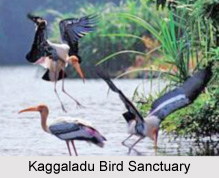 Kaggaladu Bird Sanctuary is a breeding ground for herons and this bird sanctuary in Kaggaladu is actually a small village in Sira Taluk of the district of Tumkur, Karnataka. But the surprising thing is that they nestle on a particular tamarind tree every year. However in 1996 due to poachers some of the birds were killed in the region of Muddakanahali. From then onwards the villagers had taken it upon themselves to conserve these rare species. From 1999 onwards, Kaggaladu Bird Sanctuary has been a safe haven for Grey Herons and Painted Storks, which build nests on the trees of the village. The sanctuary is existent at a distance of nearly 9 kms from the north-western portion of Sira, on the Sira-Chengavara Main Road.
Kaggaladu Bird Sanctuary is a breeding ground for herons and this bird sanctuary in Kaggaladu is actually a small village in Sira Taluk of the district of Tumkur, Karnataka. But the surprising thing is that they nestle on a particular tamarind tree every year. However in 1996 due to poachers some of the birds were killed in the region of Muddakanahali. From then onwards the villagers had taken it upon themselves to conserve these rare species. From 1999 onwards, Kaggaladu Bird Sanctuary has been a safe haven for Grey Herons and Painted Storks, which build nests on the trees of the village. The sanctuary is existent at a distance of nearly 9 kms from the north-western portion of Sira, on the Sira-Chengavara Main Road.
During the year 1999, a few members belonging to Wildlife Aware Nature Club, which is an NGO located in Tumkur had spread awareness about this wildlife sanctuary. Thereafter, people came to imbibe knowledge about the existence of Kaggaladu Bird Sanctuary. The regional inhabitants of Tumkur have asserted that Grey Herons have been building their refuge here ever since 1993. Some of the local residents made attempts to preserve these birds as they were impressed by their charm, while several others are of the opinion that such birds are messengers of prosperity and harmony. These people are so dedicated towards the species that they have stopped cultivating and harvesting tamarind inside the park. Some of these trees are privately owned while some had been donated by the state Government. The herons stay at Kaggaladu Heronry for around six months. They arrive here in February and stay till August. By the end of the month they migrate to another place. Within this time span they build nests, lay eggs and rear young ones.
Herds of blackbuck and the Great Indian Bustard are also said to wander in this sanctuary, according to the accounts of some villagers. Numerable foreign migratory birds are also found in the Kaggaladu Heronry Wildlife Sanctuary. In this bird sanctuary, one can find the birds in hundreds of number, but the big gathering of birds is not of the same feather. The tamarind trees have been maintained exclusively for birds shelter and nestling. It has been reported that, the villagers of Kaggaladu are very much attached to these migrating birds.
Kaggaladu Bird Sanctuary is also known to be the world`s second largest sanctuary for painted storks, particularly in southern India. Several species of foreign birds also flock to this sanctuary. Kaggaladu Bird Sanctuary in Karnataka, thus, has also become a popular tourist destination. From Sira district the forest reserve is accessible from Sira and Tumkur by road. The nearest railway stations are Bangalore and Tumkur.











